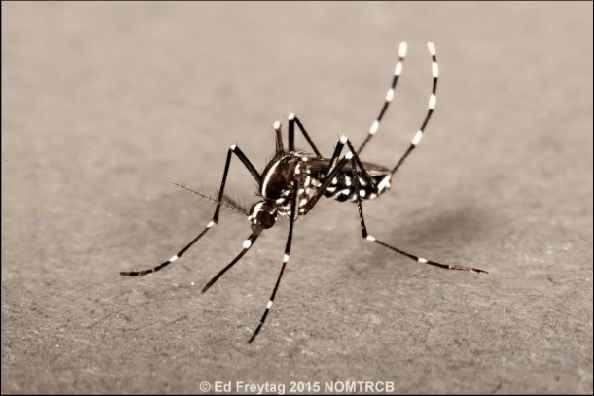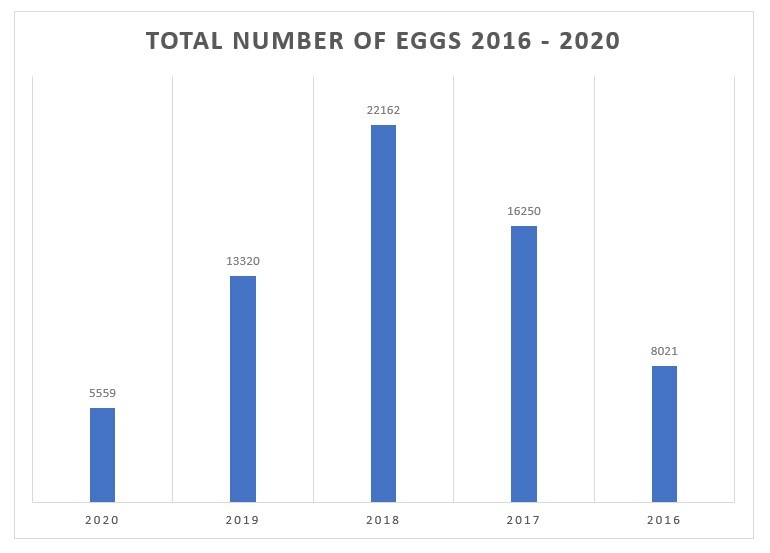Asian Tiger Mosquito Protocols
The Asian Tiger Mosquito (ATM), Aedes albopictus, is an invasive species that can present intense biting pressure to mammals including humans during daylight hours. Their preferred habitat is artificial containers such as tires, and tires imported into an area can establish a population that can quickly become difficult to control. CMMCP monitors for this species in all life stages; egg, larvae and adult.

- Eggs: Special cups called ovicups are placed in areas of possible ATM presence, and they are lined with special paper that the female mosquito then lays her eggs on. These papers are then brought back to the CMMCP laboratory and the eggs are counted. Special handling procedures are used, and the eggs are sent into the MDPH lab for rearing and identification. The chart below shows the number of eggs collected and submitted since 2016. None of the eggs hatched to date have been identified as Ae. albopictus.

- Larvae: Technicians collect larvae from a variety of locations each year and our entomologists are specially trained to identify larvae to species.
- Adult: ATM have preferences for certain mosquito traps such as the BG Sentinel and BG-GAT trap. These traps can be used for both identification and control of ATM.
Once presence of ATM is confirmed by any of the methods above, we have the following control protocols in place:
1.) Single identification:
- Coordinate with property owner(s) and discuss source reduction strategies
- Additional surveillance using best available products and methods
- Larval control using best available products and methods
- Adult control using best available products and methods
- Continue surveillance for minimum 2-4 weeks or until weather conditions deteriorate
Details:
1a: Survey area and check for containers, tires, etc. Offer advice and educational materials on basic mosquito biology and control in coordination with LBOH. Offer tire recycling services if appropriate.
1b: Supplement adult surveillance traps in area with different trap types to gauge overall species composition and population densities.
1c: Treat tire piles & other permanent water-holding containers with extended release larvicidal products; treat/empty smaller containers if possible. Recommend removal of water-holding containers to property owners.
1d: Set up autocidal gravid ovitraps or other ATM collection devices; ULV area as close to dusk as possible 1-2 times minimum in the first weeks following identification.
1e: Determine if Ae. albopictus presence continues.
2). Multiple identifications:
- Coordinate with property owner(s) and discuss source reduction strategies
- Coordinate community outreach with LBOH’s
- Additional surveillance using best available products and methods
- Weekly larval control using best available products and methods
- Multiple adult control applications using best available products and methods
- Continue surveillance until weather conditions deteriorate
Details:
2a: Re-survey area and check for containers, tires, etc. Aggressively market educational materials to area residents on basic mosquito biology and control in coordination with LBOH. Highlight tire recycling services to the public.
2b: Work with LBOH using social media, traditional media and Internet to education and inform public about Ae. albopictus.
2c: Continue supplementation of traps in area with different types to gauge overall species composition and population densities. Prioritize identification and virus testing from this area.
2d: Monitor and treat tire piles & other permanent water-holding containers as needed with extended release larvicidal products; treat/empty smaller containers if possible. Consider and prioritize removal of tire piles. Recommend removal of water-holding containers to property owners.
2e: Set up autocidal gravid ovitraps or other ATM collection devices; ULV area as close to dusk as possible 1-2 times in the first weeks following identification. Consider barrier treatments in area especially near container sites.
2f: Determine if Ae. albopictus presence continues until 2 consecutive hard frosts.
2g: Monitor location the following season

